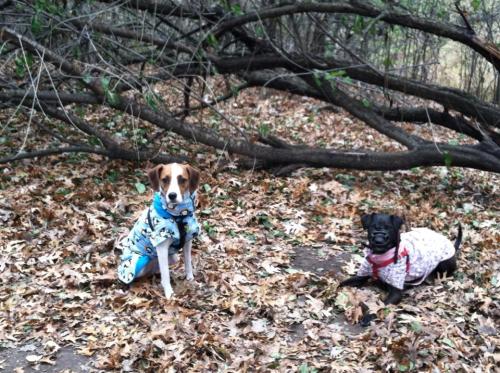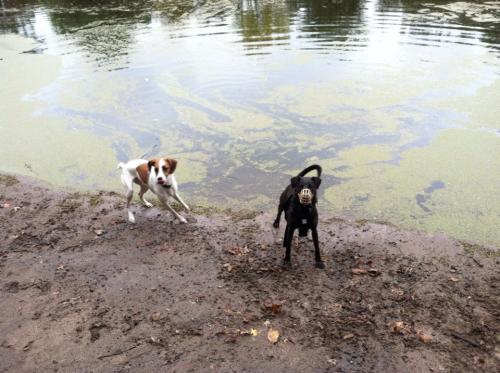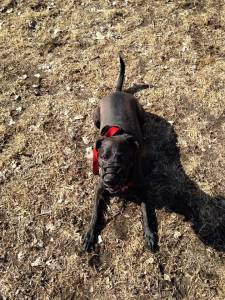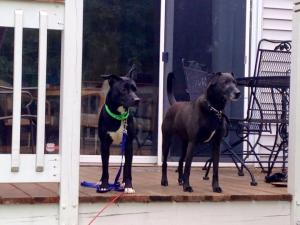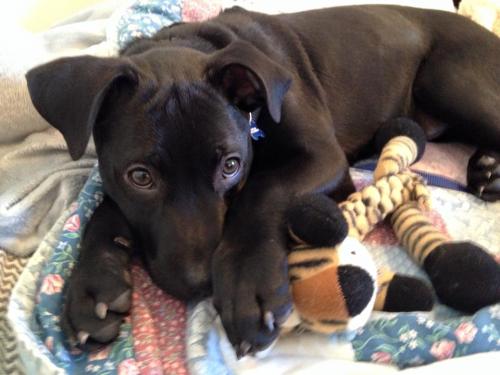Last week I discussed the management techniques I used to keep Trout and Layla safe and separate after their recent fight and resulting injuries. I cannot emphasize how very important management was in our success – without it, I doubt we would have ever been able to get the two girls back together. That said, there was still some work to be done. Today, I’ll cover the training and behavior modification exercises that we employed to reintroduce the two dogs to one another.
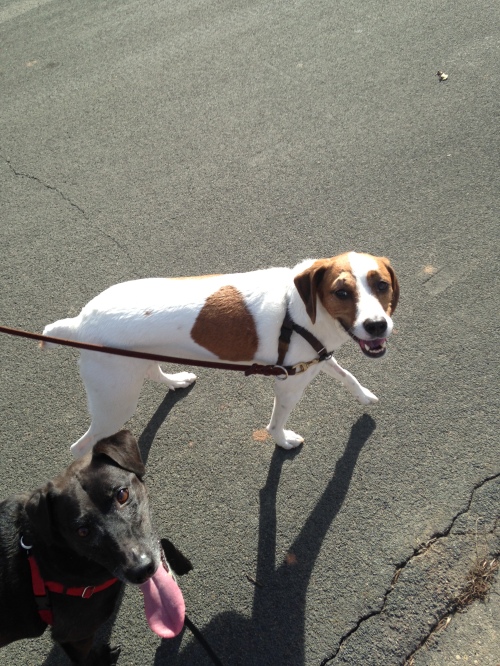
Starting right away, we began to do short sessions with the dogs on opposite sides of their gates or ex-pens. We would take the blankets off the gates so that the dogs could see one another, walk them within sight of each other, then feed them lots of treats. After 10-20 seconds of treating, we would walk one of the dogs out of sight and immediately quit feeding both dogs. The premise was simple – good stuff only happened when the other dog was present.
When we first started these exercises, the dogs were noticeably worried. Trout frequently stared at Layla and sometimes growled, her posture stiff and upright. Layla avoided confrontations, looking away and licking her lips, clearly frightened. This behavior on Layla’s part was quite surprising to me. In the past, she’s always been eager to engage if another dog started something, but I suspect that with her increasing age (she’s nine years old) and injured leg she just wasn’t feeling up to another confrontation. When Trout growled or postured, her handler instantly stopped treating or paying attention to her and walked her away, while Layla’s handler praised and treated her for avoiding conflict while also moving her further away. We never allowed growling or posturing to continue for more than a second before intervening. Remember, practice makes perfect – and we certainly didn’t want Trout to get better at these behaviors!
Within a couple days, these positive conditioning sessions began to show real results. Trout’s posturing became less intense and Layla’s appeasement signals likewise lessened. Both dogs began to visibly brighten when they spied their housemate on the other side of the gate or ex-pen, looking for their treats. They also began to signal in friendly ways towards one another, sniffing from a distance and returning calming signals. We praised them enthusiastically for any pro-social behaviors, and Trout especially seemed to really need this extra reassurance that she was doing well.
As she became less insecure around Layla, Trout’s posturing and growling melted away. This is an important point. Frequently, owners think that their dogs are growling because they’re pushy, mean, or status-seeking. However, much like Trout, these behaviors are often an indicator of a problem with insecurity. Imagine, then, the damage that can be done by punishing a dog for growling or otherwise displaying their discomfort. Not only would punishment have potentially suppressed growling and other very useful indicators of Trout’s comfort level, but it also would have completely reinforced her belief that she was correct to worry when Layla was around. By pairing Layla’s presence with good things (treats! praise! neck rubs!) and viewing any growling as information that the dogs were too close, we were able to quickly change Trout’s reaction to Layla for the better.

Oops! Sometimes we made mistakes. Here, Trout got way too close to Layla, and began to display whale eye and close her mouth – both major warning signs. We immediately put more distance between the two dogs, and Trout once again relaxed.
At this point, we began taking short walks multiple times a day – just halfway to the corner at first, then all the way to the corner. We started by walking the dogs across the street from one another, moving them in the same direction but allowing for plenty of parallel distance between them. Both dogs were given treats for looking at the other dog in a soft manner, as well as receiving frequent rewards for walking nicely. If either dog began to look tense or nervous, we immediately veered further away from one another, giving them even greater distance. When they were both soft and relaxed, we moved slightly closer, lessening the distance between the two.
Within a week, the two dogs were able to walk side-by-side in a relaxed manner. They began sniffing each other as they walked, and following one another to especially enticing smells. They started to urine mark over special smells together. While they were still kept completely separate inside, their outdoor walks allowed them to start interacting as a team once again.
Inside, we continued to experience problems with guarding. Both dogs guard resources (food, toys, special resting places), so we had to be very aware of potential triggers. If either dog growled or stared at the other, the offender was immediately but calmly escorted to a crate or room for some alone time, while the dog who had been growled at was rewarded liberally with treats and praise for not responding. In just a few days, Layla began to run to the treat cupboard and wait for a reward during the rare moments when Trout happened to growl, and both dogs began to posture and threaten the other less frequently.
To begin working on reintegrating the dogs indoors, I returned to one of my favorite tools for behavior modification – the Protocol for Relaxation. This step-by-step protocol teaches dogs to relax while stuff happens around them, and both Layla and Trout were already quite familiar with it. I started running through the protocol once or twice a day, at first with the dogs lying on mats on opposite sides of a baby gate, and later with them side-by-side but with Trout tethered. After a week of successful protocol repetitions, when both dogs were looking soft and relaxed on their mats, I untethered Trout. Outside of training sessions the dogs continued to be kept separate, but while we were actively working on the protocol they were able to be loose together, relaxed on their individual mats.
These three main exercises – positive associations on opposite sides of the gate, parallel walks, and the Protocol for Relaxation – set the stage for a successful reintroduction. Within a week, we began allowing the dogs to pass by one another off-leash without interacting when switching them into different areas of the house, and later began to allow short (2-5 minute) periods of time when they were loose together but heavily supervised. We continued to keep them apart for the majority of the time, but built up the amount of time they could be around one another gradually.

Relaxing during the Protocol for Relaxation, off-leash together and all healed up!
Reintroduction after a serious fight is a slow process, but it was worthwhile in the end. After a month of gradual reintroductions, we were able to take the ex-pens and baby gates down completely. The dogs continue to be separated if left unsupervised (something we’d done prior to this incident as a matter of course), but are otherwise peacefully coexisting once again. Three weeks into this process, the two began playing together once again, at first with frequent breaks and exaggerated body language, and then with more relaxed signals as they once again became comfortable with one another. Today their interactions have returned to the pre-fight levels of peace and playfulness.
While I’ve coached many, many clients on reintroductions such as this, I’ve never before experienced inter-dog issues with my own pets at such a serious level. I can empathize with the stress and anxiety of dealing with dogs who don’t get along. My mantra for clients in similar situations has always been that “slow is fast,” and Layla and Trout were proof that this is indeed the case. Anytime we tried to rush through exercises or pushed the dogs, things fell apart. Allowing both girls time to heal, physically and emotionally, and setting them up for success with one another, gave them the tools to progress at their own paces and eventually to rebuild their relationship. We’ll continue to be vigilant in avoiding situations that could trigger a repeat of their fight, however I feel confident in saying that the dogs are better equipped to avoid conflict in the future due to the hard work we put into helping them succeed during this time.
If you’ve ever experienced inter-dog aggression in your own household, I hope your experiences at reintroduction were every bit as successful as ours. Remember, slow is fast, and it’s important to work at your dogs’ own paces. Feel free to share your tips, tricks, and stories in the comments section below.
 (Caption: Bear’s safe spot on his first day home.)
(Caption: Bear’s safe spot on his first day home.) (Caption: Now Bear likes to go out on adventures in the winter more than I do!)
(Caption: Now Bear likes to go out on adventures in the winter more than I do!) (Caption: Bear at Paws Abilities’ north Rochester location, smiling his big, goofy smile.)
(Caption: Bear at Paws Abilities’ north Rochester location, smiling his big, goofy smile.)
